Performance Midrange Common Components
While AMD and Intel architectures differ in sockets and sometimes memory configurations, more is the same than not with the two systems. For that reason the Intel and AMD value midrange systems share a number of common components.
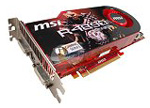 |
If you refer to the recent launch article on the ATI 4890 and NVIDIA GTX 275, you will find these two cards were initially the new choices for the $250 price point. Since then the very popular ATI 4890 has seen tremendous price competition among those selling the card. As a result, an overclocked 4890 can be had for $170 today after $30 rebate. While the GTX 275 performs similarly, it remains around the $250 selling price, with an occasional rebate pushing the price near $200. That is the reason the MSI 4890 OC is the video card choice for both performance midrange systems.
If you prefer NVIDIA cards or NVIDIA drivers, the GTX 275 is an easy substitute in either system. Either card will do the job well and you can shop based on price. The edge goes to the ATI 4890 in the resolutions you will likely run (1920x1200 or lower) with a 27" or smaller display. If you have a 30" monitor, the GTX 275 performs a bit better at those super high resolutions.
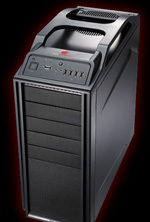 |
The case receives a significant upgrade with the selection of the unique Cooler Master Storm Scout mid-tower case. The Scout has many endearing features, but we would point out the unique rear cutout behind the CPU on the motherboard tray. That makes it possible to install many "through-the-board" aftermarket CPU heatsinks without removing the motherboard. It's a truly clever and useful design element, and we'd like to see more cases support such a feature. The top-mount handle and quiet, effective cooling are also big pluses. Some also want a unique appearance and the Storm Scout delivers with its red LED glow in a distinctive looking case.
Alternates are the Antec Nine Hundred at about the same price and the Antec 902 or Cooler Master Storm Sniper at $160. Both alternatives are very popular with system builders and buyers praise the build quality of both cases.
 |
AnandTech and many other review sites have praised the solid construction, performance, and value of Corsair power supplies. It should come as no surprise that the Corsair 750TX is the choice to power either performance midrange system. The power supply is SLI Ready and CrossFire Ready, 80 PLUS Certified, and Core i7 ready. Power is delivered to a single 60A 12V rail for those looking for that feature and finding it hard to come by at a reasonable price. With a $20 rebate the final cost is $100, which is a great value for a PSU with these specifications, features, and performance reputation.
Most of our editors consider the onboard audio of motherboards to be more than adequate for even gaming these days. That is why we have not chosen a sound card for the performance midrange system. If you want more than onboard surround sound then we recommend the Auzentech X-Fi Forte 7.1 for serious gaming at $140. HTPC users will find much to like in the ASUS Xonar HDAV 1.3 Slim. Other good choices are the ASUS Xonar Essence STX for music, in particular for serious headphone users, or the HT Omega Claro Halo - both run about $200. If you are looking for a good general purpose onboard audio upgrade the HT Omega Striker 7.1 should fit your needs at around $90.
 |
The optical drive for a performance midrange system needs the ability to play Blu-Ray disks. A new model was chosen here with the faster 8X BD read speeds, the LG CH08LS10 Blu-Ray/DVD combo drive. In addition to 8X BD and BD dual-layer playback, you can burn DVDs as fast as 16X single-layer or 12X DL. It cannot, however, burn 25GB/50GB Blu-Ray disks. Adding that capability increases the cost to around $200 to $250. BD burners like the $200 LITE-ON 4X BD-R SATA burner or the $230 LG GGW-H20LK 6X Blu-ray burner are good choices.
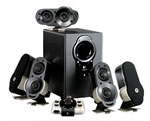 |
Speakers have been upgraded to the Logitech G51 155W RMS 5.1 surround sound speakers. The Logitech rebate has ended, but you can still find the G51 for as little as $120 if you shop, which makes the G51 an excellent value.
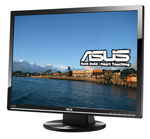 |
The LCD display resolution maintains the 1920 horizontal pixels of 1080p displays but moves to a 26" WUXGA display with a 1200 pixel height. Whatever the minor resolution differences the size of the monitor is increased to a nominal 26" so everything on screen is a little larger (0.292mm pixel pitch). The ASUS VW266H 25.5" HDMI widescreen provides the preferred HDMI input, as well as DVI and an analog VGA port. Panel speed is rated at an incredible 2ms, but we have found most current LCD panels perform similarly and the speed rating does not really guarantee very much. The ASUS monitor provides a large sharp image, good colors, and fast panel speed at a very good price of $300 after rebate. It comes with DVI and VGA cables, but if you plan to connect with HDMI you will need to buy an HDMI cable.
As most readers are aware, LCD panels have been going to cheaper panel technologies and generally declining in image quality. Despite that fact, most buyers are reporting that they are pleased with current LCD screens. It you have a need for exceptional color or yours is a mission-critical graphics task, you may want to look at the HP LP2475w 24" 1920x1200 monitor. This HP monitor is likely the best quality 24" monitor you can buy today, with superior panel technology (S-IPS) and image quality likely to satisfy graphics professionals.
The remaining components are the same as our value systems. The hard drive remains a 1TB WD. The Microsoft OEM keyboard and optical mouse provide input and Vista Home Premium OEM runs the system. For more information on these components you can refer to descriptions on p.3.
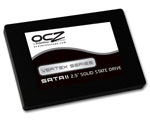 |
In response to those who have asked for SSD recommendations, it is possible to do so based on the months of research and testing performed on SSD drives at AnandTech. For more information on SSD test results please see our SSD Anthology and our SSD update. As we recently reported, you should be on the lookout for further price reductions expected in the next few weeks. The short summary is that the new Intel X25-M G2 SSDs are the top performers, but the price-reduced Indilinx options like the OCZ Vertex and OCZ Agility are viable competitors.










71 Comments
View All Comments
ChrisOjeda - Monday, July 27, 2009 - link
Will onboard video (like ASUS M4A78T-E) be a solid solution for somebody that does no gaming, but would like to make a home theatre box for watching movies, playing music, and viewing pictures using a Windows solution. I have no intention of gaming on the machine and don't want to spend more than necessary for a video card. Assume all other components the same.JarredWalton - Monday, July 27, 2009 - link
Yes. If you're a stickler for audio, make sure it's an IGP that can handle multi-channel LPCM audio output. NVIDIA has had this for a while, Intel added it a year or so back, and http://www.anandtech.com/weblog/showpost.aspx?i=62...">AMD just added it with the R785 (HD 4200).garydale - Monday, July 27, 2009 - link
The AMD 790GX chip does pretty reasonable graphics for the non-gamer so I went with the Gigabyte GA790GP-UD4H (or some similar number) board. The six onboard SATA2 ports meant that my software RAID 5 array (4 x 500G) still allowed me to plug in a SATA DVD rewriter.With a Phenom II 940 processor, the total build (less monitor - still using an old Dell 21" trinitron) was pretty small. I found a 470watt PC Power & Cooling Silencer on sale last year and stuffed it in a case I'd picked up years ago.
The processor runs quite cool thanks to the new cooler AMD puts on them - about the same temp I was getting with with an earlier Phenom X4 and a Gladiator Max cooler. It's the hard drives that are running hot, so I'll need to add another fan at the back to pump more hot air out.
Just waiting for the Blu-ray burner costs to come down. They haven't really moved in the last year, which is disappointing. Does anyone have any idea on why the prices are staying high? I notice the media prices have been dropping, so when can we expect a $100 Blu-ray burner?
goinginstyle - Monday, July 27, 2009 - link
I was surprised that I did not see a AMD 770 or cheap Intel P45 based system with the 4890 as the video card choice for the midrange system. The money you save on the board allows you to upgrade the video card choice and performance looks to be the same. Maybe overclocking is not as good but does it really matter that much.You end up with a single video card on the board but it also allows you to save money on the power supply choice, which might get you a better audio selection or two hard drives. I think having alternatives listed in these guides would be good, otherwise most of the choices were solid.
brybir - Monday, July 27, 2009 - link
I was looking for the 780G as well. I think they were looking for "gamer" boards with the option to Crossfire or SLI or whatnot over strictly budget options since this is a "middle of the road" system guide for both casual gamer types as well as those in the upper end of the price range who want very good system speed.If I were building a mid range system (I am going to build one come early 2010 when Intel's i5 line is more flushed out and the new gen of graphics cards are released in oct/now) I would probably pick up a 780G board and use the money to go from the 4870 to the 4890 or even just use the money for a bump in LCD quality.
Black Jacque - Monday, July 27, 2009 - link
This article makes some good points in graphics and CPU selection. However, it shows the Editors have a poor understanding of PC power consumption.By reasonable accounts, all the PSUs in the recommended systems have twice the rated wattage that the parts lists will draw at full core-burning maximum. For the mid-range, a 400W-450W PSU is more than enough.
The recent, excellent Xbit Labs article "PC Power Consumption: How Many Watts Do We Need?" clearly illustrates that 750W PSUs are a waste of money in the mid-range when not going with SLI or Crossfire. This article shows the trend in PC parts is downward in power consumption.
When building a mid-range machine, you need to keep your eye on your budget. You are trading dollars for performance in every choice. A 450W PSU is less expensive than a 750W PSU. That difference is one budget bump UP toward either a: faster CPU, an upgraded GPU, or more RAM.
The high-wattage PSUs in the parts lists show a poor understanding of PC power consumption. Selecting lower wattage, PSUs that perform as needed in high performance situations (and more efficiently at idle) allows for higher performance parts to be used in the price/performance mid-range categories, or generally lower the cost-of-entry to a category. I expected a more canny and not “Big is Best” recommendation of PSUs in this article.
The0ne - Monday, July 27, 2009 - link
While there's already arguments going back and forth on this it's usually a good idea to buy a beefier but not necessarily more expensive PS. The reason is because many users don't have the capability to determine precisely how much power their system is consuming. Hell, I'm an Engineer and I don't have the tools at home to even do it. So I can't expect the same for your average Joe to be capable of. Secondly, not all low range, mid-range or high end configurations are the same. Some have more components and some have the basics. Having more requires a bit more power.In addition, not all power supplies are created equal. Even same power supplies are not exactly the same. And while specs are great to look at chances are if you don't know what you have in the first place it's best if you look for a performance/price deal that is more than what you "think" you need.
Due to reviews I keep seeing people make comments like "consumers only need 400-450 watt for their mid-range computer!" While this may be true for most cases it is not entirely 100% foolproof. For example, my 600watt PS in my main refuses to run my new 4870 1Gig video card where it's already powering my current 9800GX2. Why, I've no idea. I just know that I had spent hours trying to determine it with little success except the PS is not what the specs are telling me.
So I pop in the OCZ 700, after doing some research and knowing I would have some good buffer afterward, and my system is running just fine. I'm not maxing it so I really don't have to pay attention to the tight specifications. What matters was that I bought it for $50 when it was on sale and there wasn't a similar PS that came close in price. That's what importantly :)
SiliconDoc - Wednesday, August 5, 2009 - link
You don't need home tools to determine what PS requirements are, there are tools all over the internet - how about one form the experts:http://www.thermaltake.outervision.com/">http://www.thermaltake.outervision.com/
---
Now they make PS's and you would think they would promote a higher number, but run through it once and you'll likely find a much lower result than you expected.
The0ne - Monday, July 27, 2009 - link
Speaking of PS, here's the one I got...and it's on sale again for $49 after rebate :ohttp://www.zipzoomfly.com/jsp/ProductDetail.jsp?Pr...">http://www.zipzoomfly.com/jsp/ProductDetail.jsp?Pr...
Nfarce - Monday, July 27, 2009 - link
"For the mid-range, a 400W-450W PSU is more than enough. The recent, excellent Xbit Labs article "PC Power Consumption: How Many Watts Do We Need?" clearly illustrates that 750W PSUs are a waste of money in the mid-range when not going with SLI or Crossfire."Uhm, yes and no. As someone who recently build an E8400 mid range gaming system who also has the Corsair 750W, there are things you need to consider other than pure wattage. For instance there are hardly any quality power supplies in the 450-550W range that offer 2 6-pin PCIe connectors (a requirement to run HD 4870/90 and GTX 260/275 cards). Finally, the ones that do aren't that much less expensive. If you are going to spend $75 on a minimum requirement power supply, it makes good long term sense to throw in another $25 and get a more powerful PS for your future upgrade needs. Power supplies, unlike other PC components, don't really drop in price over time.